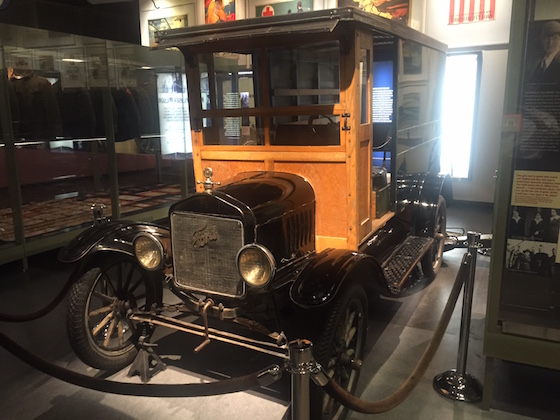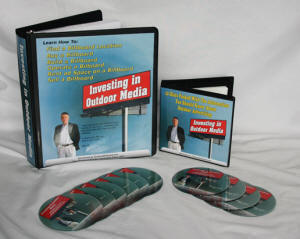Memo From Frank
The Brexit collapse of world markets has highlighted the benefits of being in low-tech industries with no exposure to foreign markets or currency fluctuations. And there’s probably no industry that is more low-tech than billboards. There’s only one moving part – the time clock. As we watch the stock market plunge and companies like Apple get punished for complicated derivatives that we don’t even understand the algorithm for, it’s reassuring that billboards just sit there. In today’s world, boring is good. There are a thousand companies in the U.S. and abroad right now that wish they were in the billboard business.
Why Canadian Billboards Look Different

I get asked all the time about the similarities and differences between Canadian billboards and those found in the U.S. While Canada has many similarities to the U.S., the billboard industry could not be more different. And that’s why you find little overlap in owners of U.S. and Canadian billboard assets.
Different sizes
The American billboard market has some definitive sizes as their staples: 14’ x 48’, 10’6” x 36’, 12’ x 24’. The Canadian market is much more fragmented. It is not unusual for every sign on a stretch of highway to be a different size. Much of this comes down to the way that the markets matured over time. The U.S. industry was dominated by a few key players (such as Foster & Kleiser) while the Canadian market had many more entrants. Since there was not as much dominance by a single group, the sizes in Canada are erratic. This lack of standardization makes every billboard in Canada virtually a one-off custom unit.

Different construction methods
Canadian signs look very different from the U.S. physically. They involve much more angle-iron and much fewer monopole construction. Again, this is a function of the age of the units. Monopoles became popular in the 1980s, and much of the Canadian city outdoor units were built prior to that period. You can spot the difference immediately if you look at a vacant billboard frame – it’s got about ten times more pieces to it.
Different laws regarding permits has led to more wooden signs
The laws regarding permits are a huge difference between the U.S. and Canadian markets – and probably one of the biggest drawbacks to owning signs in Canada over America. In the U.S., the permit goes “with the sign”, so whoever owns the sign controls the permit (which is the billboard company). In Canada, the permit goes “with the land” which means the property owner has freedom of choice on each lease renewal. This creates a great deal of instability in Canada, as the sign owner who signs a 5 year lease faces losing the location at the end of the lease to open bidding, while in the U.S. the laws typically render the sign legal non-conforming (grandfathered) which means that the billboard company holds all the cards. This is why so many signs in Canada are built of wood – the sign owner has to build it cheap because they may well lose the sign at the end of the lease.

Other subtle differences
One main appearance difference in Canadian outdoor is the lack of skirting. Most Canadian signs have none. This is a cultural difference, as the skirting has no purpose other than to hide the superstructure, which the Canadians leave exposed. Additionally,, without the skirting, there are few shields identifying the sign company.
Conclusion
Canada does have billboards. But it does not have nearly as many of them as the U.S., and the industry is very different there. Between the two, you definitely want to stick with American outdoor.
The “Good Old Days” Have Been Drastically Improved

Some people are always reminiscing about the “good old days”. But the billboard industry of today is far superior to what it used to be for a number of reasons.
The replacement of hand-painting with vinyl
This was the industry’s big game changer that began in the 1990s. Prior to the invention of vinyl, billboards had to be hand-painted on location, or in shops and them installed by crane. It was extremely labor intensive and costly. To paint a pictorial billboard used to cost around $5 per square foot (about $10 sq. ft. today). That’s compared to vinyl printing which costs less than $1. And that savings goes straight into sign owner’s pockets. Additionally, painting created problems with scheduling, as the sign owner was completely at the mercy of Mother Nature. If it rained or had high winds, that day was lost. Today, the vinyls are printed indoors, and are able to be installed during conditions that made painting impossible. They have also removed the risk of paint falling on cars, and painters falling off signs.
The replacement of direct current lighting with ballasted LED
Early billboards had light bulbs just like you might have on your garage. This is called “direct current” and it is extremely expensive. A single light on a sign might cost $100 + per month in electricity, The modern billboard is lighted using ballasted and often LED bulbs, which use a fraction of that amount, In addition, ballasted bulbs last longer – much longer. And that saves a ton in repair costs.
The destruction of billboard competitors with the internet
Back in the old days, billboards were the weakling among the media choices of television, radio and newspaper. A billboard salesman would beg for the scraps of the budget after these were satisfied. However, then the internet came to town in the 1990s and blew those media competitors to bits. Today, billboards are the only form of advertising that does not require competition with internet entertainment to get viewership. Just look at the stock of Lamar (a billboard operator) and those television, radio and newspaper companies.
Conclusion
The good old days for billboards featured great advertising design and some interesting structures with plaster finials and columns. They included moving coffee cups and starlets diving into pools. But they also had a great deal of complications and dangers. The good old days for billboards are actually today.
Billboard Home Study Course
![]() How to Find a Billboard Location
How to Find a Billboard Location
![]() How to Buy a Billboard
How to Buy a Billboard
![]() How to Build a Billboard
How to Build a Billboard
![]() How to Operate a Billboard
How to Operate a Billboard
![]() How to Rent Ad Space on a Billboard
How to Rent Ad Space on a Billboard
![]() How to Sell a Billboard
How to Sell a Billboard
Get Your Copy Now!
Assessing Your Sales Weaponry

So you’ve got a vacant billboard to rent. The first step is to properly assess what you sign’s strengths and weaknesses are, so you can develop an effective marketing plan to rent that space. So how do you do that?
Traffic count
How many people does the sign reach each day? You can get this statistic from the Highway Department, or your local city our county. These counts are very basic and require a great deal of guess work. Note that these counts are typically “two way” counts, so you have to take the number and divide by two. At the same time, most sign owners claim that each car carries an average of two occupants, so they take that number and multiply by two (which takes you back to the original number). This statistic is extremely important to your advertiser.
Demographics
What kind of people does the sign reach? Rich? Poor? This is called “demographics” and, again, it’s a very rough science. Nobody really knows exactly who is in those cars. But most people feel that the demographics roughly follows the location of the sign, so a sign in an upscale part of town reaches rich people and the rough part of town reaches those less affluent. In certain cases, the demographics can be more defined, such as on Hollywood Blvd. in Los Angeles, in which all movie executives have to drive down that one street to reach the studios.
Proximity to advertisers
A billboard in the middle of the desert will not have nearly as much to work with as one in the middle of town. Since most advertisers want an “exit now” sign, the more advertisers you have at the exit, the better. You need to know what volume of potential suitors your sign has, as it will have an impact on how tough a negotiator you can be.
Pricing
You can never go out to the market without knowing what to charge for the sign. To get that price, you need to become an expert on the market. And you accomplish this by calling around and finding out the price on all of your competitors’ signs. There’s no shortcut to this step. And don’t think you can gather this data on-line, as the “rate cards” you find on the internet are just fantasy numbers that are rarely achieved.
Competitors
You must always have a firm handle on your competitors to be an effective player. You should know exactly what signs are vacant near your sign, and how much they rent for, and how long they’ve been vacant. This will allow you to gauge how hard a bargain you can push for. Remember that those competitors are also sizing you up, and it’s a dog-eat-dog world out there.
Conclusion
When you have attained the foregoing information, you will be ready to proceed with your marketing program to rent your billboard. Without this data, you will never be able to maximize your efforts.
Understanding How To Make Money With Mobile Billboards

Mobile billboard are terribly misunderstood. It’s more than just buying a used truck and starting to drive around. There are successful business models and complete failures that have been tried with this medium. Stick with the good ideas.
Understanding the limitations of traditional mobile signs
A traditional mobile billboard reaches very few people. As it drives through town, only those cars directly behind it read the message, and that flow of traffic rarely changes. When they were first introduced, most companies realized that just driving about with a sign on your truck was going to be a big money maker.
How to create the hybrid of mobile and static
Then people learned that they could park those trucks and merge a mobile sign with a traditional static one. That’s become the new business model. The photo above is just such an item, a truck parked at a high traffic spot in downtown. You park for the day and then drive on. Since traditional billboards are typically illegal in these areas, you are basically circumventing the law by having your sign in the form of a vehicle which has the right to park. And vehicles are seen by pedestrians, while billboards up in the ari are not.
Creating a market for this product
Think of who can benefit from this advertising form. A product or service that reaches a certain niche market that is hard to reach with regular advertising is key. For example, a new health club that is in downtown needs to reach folks who live and work there. Or a new drink needs to reach those who are walking around the “club” section of town. Think from the perspective of the advertiser, not your own.
Low entry cost is the key – as well as flexibility
What attracts more people to mobile billboards is the low entry cost. You can find these for sale for a few thousand dollars as used equipment. Or you can build your own. People are also drawn to the flexibility, as you can dive right into a market without the laborious effort of getting a billboard license, negotiating a ground lease, obtaining a permit, etc.
Conclusion
Mobile billboards are great – if you know how to use them. A sensible program that puts the goals of the advertiser first is almost always a success.
New Billboards For Sale On OutdoorBillboard.com
A Visit To The Steamboat Arabia Museum In Kansas City

I love driving, as it can take you places you’ve never seen before. Case in point, the Arabia Steamboat Museum in Kansas City. This museum houses the remains of the Arabia, which sank in the Missouri River in 1856. It is the largest collection of pre-Civil War items in the world – almost 100 tons of them. It’s amazing that three guys with a metal detector could find this giant ship in the middle of a Kansas farm field in 1988. There is a natural tie to billboards and driving, and I always enjoy where the road takes me.
The Market Report
Prices Are Delayed By At Least 15 Minutes
